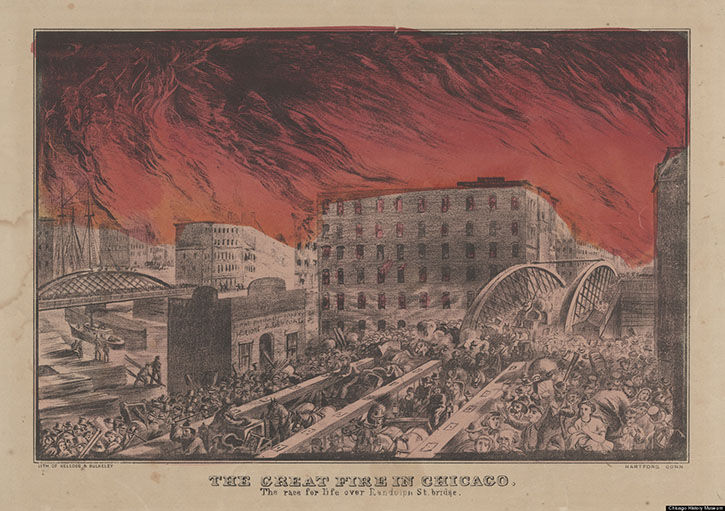
Like a Phoenix Born from the Ashes

by Chantal Chuba (MA 2017)
“The artists stood helpless in their anguish, but still hoping, praying, that their cherished home might be spared,” wrote Alvah Bradish, one of many students whose art-minded ambitions were interrupted on October 9, 1871, when the the School of the Art Institute of Chicago, once known as the Chicago Academy of Design, was consumed by the Great Chicago Fire.
The origin of SAIC can be traced back to the year 1866, when 35 local artists met in a studio on Dearborn Street to form the Chicago Academy of Design. These artists intended to create a free school of life and antique drawing and to run a gallery that would sponsor cultural events. This first endeavor proved financially unstable, but a new group of officers revitalized the plan and resumed Academy courses at Crosby's Opera House, once located on Block 37 at the corner of Randolph and State Street. With daily courses, a growing body of students, and a new charter from the State of Illinois, it became evident that the Academy needed its own building in order to continue to grow. Plans were made to contract a five-story structure at 66 West Adams, which announced its inauguration on November 22, 1870, with a joyous celebration exhibition of paintings.
A full year had not even passed when the great Chicago fire annihilated this first stable home of the Chicago Academy of Design. On that fateful day of October 8, 1871, from 1:00 to 9:00 a.m., Bradish and a group of fellow artists from the Academy congregated on Adams Street, anticipating the fate of their institution. The fire had already swept across the lower west side, crossed the river, and was on its way north, eating up block after block. They were struck with fear as the heat from the burning city intensified. By 2:00 a.m., Clark Street was gone. Students witnessed the destruction spread rapidly from Wabash Avenue to State Street, engulfing the Palmer Hotel along its way. It was inevitable that the conflagration would soon consume their beloved institution.
About a month later, once the embers of the disaster began to settle, Bradish described the horrifying story in the Chicago Tribune.
She recollected the fire engulfing the building, climbing “through its broken windows, down through its noble expanse of skylight; [then] came the whirlwind of flames and murky elements…as though to proclaim a savage triumph over the fond hopes and labors of genius. Thus perished the Chicago Academy of Design.”
Thankfully, Bradish’s fatalistic conclusion proved to be fiction. Though the Chicago Academy of Design struggled through eras of rented rooms, deep debt, and political instability, it was reborn under new administration as the Chicago Academy of Fine Arts. The newly formed school opened in September of 1879 in the rented Pike's building on the southwest corner of State and Monroe, revitalized and eager to expand. In 1882, the name of the School was changed to the School of the Art Institute of Chicago, the name by which it is now known. The new financial support, leadership, and the growth that came with the 1892–93 World Columbian Exposition began its elevation to the grandiose institution and world-class museum that stands in downtown Chicago today.
Like a phoenix born from its ashes, the School of the Art Institute of Chicago not only subsisted through the tragedy but became stronger for it. The Great Chicago Fire was not an end but an obstacle, emblazoned on the 150-year history of the School of the Art Institute of Chicago.
